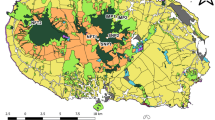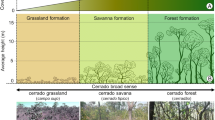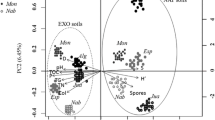Abstract
Community composition and seasonal variation of sporulation of arbuscular mycorrhizal fungi (AMF) have been studied in soils from many ecosystems including subtropical forest. Yet, AMF community composition has been surveyed only from the mineral soil but not from the litter layer and the root mat, and long-term variation in sporulation is not fully understood. We sampled a 75-m2 plot from a subtropical forest to determine AMF community composition in the following habitats: the litter layer, the root mat, and the mineral soil. Moreover, samples were taken in fall, winter, spring, and summer over a 2-year period to follow the seasonal variation of AMF sporulation. We detected 47 AMF species belonging to six families and 14 genera, Glomeraceae and Acaulosporaceae being the most represented families. Sixteen species were common to all three habitats, five species were shared between two habitats, and 26 species were recovered exclusively from single habitats. While species richness was not significantly different among habitats, AMF total spore numbers were significantly higher in the litter and root mat compared to the soil. PERMANOVA did not detect a significant effect of habitats on community composition when species presence/absence was considered, but significant differences between litter versus soil and root mat versus soil were detected when spore abundance was considered. A seasonal pattern of spore abundance for species was not observed over the 2-year sampling period regardless of habitat. This study revealed that (i) different AMF species sporulate in the different habitats; thus, field surveys considering only the mineral soil might underestimate species richness and (ii) AMF species sporulate asynchronously in subtropical forest.






Similar content being viewed by others
References
Aidar MPM, Carrenho R, Joly CA (2004) Aspects of arbuscular mycorrhizal fungi in an Atlantic Forest chronosequence in Parque Estadual Turístico do Alto Ribeira (PETAR), SP. Biota Neotrop 4:1–15
Abbott LK, Robson AD (1991) Factors influencing the occurrence of vesicular-arbuscular mycorrhizas. Agriculture, Ecosystem & Environment 35:121–150
Arbizu PM (2017) pairwiseAdonis: pairwise multilevel comparison using Adonis. R package version 0.4
Aristizábal C, Rivera E-L, Janos DP (2004) Arbuscular mycorrhizal fungi colonize decomposing leaves of Myrica parvifolia. M Pubescens and Paepalanthus Sp Mycorrhiza 14:221–228
Bahnmann B, Masinová T, Halvorsen R, Davey ML, Sedlák P, Tomsovsky M, Baldrian P (2018) Effects of oak, beech and spruce on the distribution and community structure of fungi in litter and soils across a temperate forest. Soil Biol Biochem 119:162–173
Bentivenga SP, Hetrick BA (1992) Seasonal and temperature effects on mycorrhizal activity and dependence of cool and warm-season tallgrass prairie grasses. Can J Bot 70:1596–1602
Bever JD, Morton JB, Antonovics J, Schultz PA (1996) Host-dependent sporulation and species diversity of mycorrhizal fungi in a mown grassland. J Ecol 75:1965–1977
Bever JD, Schultz PA, Pringle A, Morton JB (2001) Arbuscular mycorrhizal fungi: more diverse than meets the eye, and the ecological tale of why. Bioscience 51:923–931
Blaszkowski J (2012) Glomeromycota. W. Safer Institute of Botany, Polish Academy of Sciences, Kraków
Bonfim JA, Vasconcellos RLF, Stürmer SL, Cardoso EJBN (2013) Arbuscular mycorrhizal fungi in the Brazilian Atlantic forest: a gradient of environmental restoration. Appl Soil Ecol 71:7–14
Bunn RA, Simpson DT, Bullington LS, Lekberg Y, Janos DP (2019) Revisiting the ‘direct mineral cycling’ hypothesis: arbuscular mycorrhizal fungi colonize leaf litter, but why? ISME J 13:1891–1898
Camenzind T, Rillig MC (2013) Extraradical arbuscular mycorrhizal fungal hyphae in an organic tropical montane forest soil. Soil Biol Biochemistry 64:96–102
Carrenho S, Gomes-da-Costa SM (2011) Environmental degradation impact on native communities of arbuscular mycorrhizal fungi in an urban fragment of semideciduous plateau forest. Acta Botanica Brasilica 25:255–261
Chaudhary VB, Cuenca G, Johnson NC (2018) Tropical-temperate comparison of landscape-scale arbuscular mycorrhizal fungal species distributions. Divers Distrib 24:116–128
Chaudhary VB, Nolimal S, Sosa-Hernández MA, Egan C, Kastens J (2020) Trait-based aerial dispersal of arbuscular mycorrhizal fungi. New Phytol. https://doi.org/10.1111/nph.16667
Davison J, Moora M, Öpik M, Adholeya A, Ainsaar L, Bâ A, Burla S, Diedhiou AG, Hiiesalu I, Jairus T, Johnson NC, Kane A, Koorem K, Kochar M, Bdiaye C, Pärtel M, Reier U, Saks U, Singh R, Vasar M, Zobel M (2015) Global assessment of arbuscular mycorrhizal fungus diversity reveals very low endemism. Science 349:970–973
De Cáceres M, Legendre P, Moretti M (2010) Improving indicator species analysis by combining groups of sites. Oikos 119:1674–1684
De Marins JF, Carrenho R, Thomaz SM (2009) Occurrence and coexistence of arbuscular mycorrhizal fungi and dark septate fungi in aquatic macrophytes in a tropical river-floodplain system. Aquat Bot 91:13–19
Dufrêne M, Legendre P (1997) Species assemblages and indicator species: the need for a flexible asymmetrical approach. Ecol Monogr 67:345–366
Dumbrell AJ, elson M, Helgason T, Dytham C, Fitter AH, (2010) Idiosyncrasy and overdominance in the structure of natural communities of arbuscular mycorrhizal fungi: is there a role for stochastic processes? J Ecol 98:419–428
Escudero V, Mendoza R (2005) Seasonal variation of arbuscular mycorrhizal fungi in temperate grasslands along a wide hydrologic gradient. Mycorrhiza 15:291–299
Fischer C, Janos D, Perry D, Linderman R, Sollins P (1994) Mycorrhiza inoculum potentials in tropical secondary succession. Biotropica 26:369–377
Fogel R, Trappe JM (1978) Fungus consumption (mycophagy) by small animals. Northwest Sci 52:1–29
Freitas RJ, Buscardo E, Nagy L, Maciel ABS, Carrenho R, Luizão RCC (2014) Arbuscular mycorrhizal fungal communities along a pedo-hydrological gradient in a Central Amazonian terra firme forest. Mycorrhiza 24:21–32
Friese CF, Koske RE (1991) The spatial dispersion of spores of vesicular-arbuscular mycorrhizal fungi in a sand dune: microscale patterns associated with the root architecture of American beachgrass. Mycol Res 95:952–957
Gemma JN, Koske RE (1988) Seasonal variation in spore abundance and dormancy of Gigaspora gigantea and in mycorrhizal inoculum potential of a dune soil. Mycologia 80:211–216
Gemma JN, Koske RE, Carreiro M (1989) Seasonal dynamics of selected species of V-A mycorrhizal fungi in a sand dune. Mycol Res 92:317–321
Gerdemann JW, Trappe JM (1974) The Endogonaceae in the Pacific Northwest. Memoir No. 5. The New York Botanical Garden, New York
Gerdemann JW, Nicolson TH (1963) Spores of mycorrhizal endogone species extracted from soil by wet sieving and decanting. Trans Br Mycol Soc 46:235–244
Giovannetti M, Mosse B (1985) Seasonal variations of vesicular-arbuscular mycorrhizas and endogonaceous spores in a maritime sand dune. Trans Br Mycol Soc 84:679–684
Guadarrama P, Alvarez-Sánchez FJ (1999) Abundance of arbuscular mycorrhizal fungi spores in different environments in a tropical rain forest, Veracruz, Mexico. Mycorrhiza 8:267–270
Hart MM, Reader RJ (2002) Taxonomic basis for variation in the colonization strategy of arbuscular mycorrhizal fungi. New Phytol 153:335–344
Hart MM, Aleklett K, Chagnon P-L, Egan C, Ghignone S, Helgason T, Lekberg Y, Öpik M, Pickles BJ, Waller L (2015) Navigating the labyrinth: a guide to sequence-based, community ecology of arbuscular mycorrhizal fungi. New Phytol 207:235–247
Jansa J, Erb A, Oberholzer H-R, Smilauer P, Egli S (2014) Soil and geography are more important determinants of indigenous arbuscular mycorrhizal communities than management practices in Swiss agricultural soils. Mol Ecol 23:2118–2135
Janos DP (1980) Mycorrhizae influence tropical succession. Biotropica 12:56–64
Janos DP, Sahley CT, Emmons LH (1995) Rodent dispersal of vesicular-arbuscular mycorrhizal fungi in Amazonian Peru. Ecology 76:1852–1858
Jobim K, Blaszkowski J, Niezgoda P, Kozlowska A, Zubek S, Mleczko P, Chachula P, Ishikawa NK, Goto BT (2019) New sporocarpic taxa in the phylum Glomeromycota: Sclerocarpum amazonicum gen. et sp. nov. in the family Glomeraceae (Glomerales) and Diversispora sporocarpia sp. nov. in the Diversisporaceae (Diversisporales). Mycol Prog 18:369–384
Kassambara A (2020) ggpubr: ‘ggplot2’ based publication ready plots. R package version 0.4.0. https://CRAN.R-project.org/package=ggpubr
Koske RE, Tessier B (1983) A convenient, permanent slide mounting medium. Mycological Society of America Newsletter 34:59
Kottek M, Grieser J, Beck C, Rudolf B, Rubel F (2006) World map of the Köppen-Geiger climate classification updated. Meteorol Z 15:259–263
Leal PL, Siqueira JO, Stürmer SL (2013) Switch of tropical Amazon forest to pasture affects taxonomic composition but not species abundance and diversity of arbuscular mycorrhizal fungal community. Appl Soil Ecol 71:72–80
Lekberg Y, Koide RT, Rohr JR, Aldrich-Wolfe L, Morton JB (2007) Role of niche restrictions and dispersal in the composition of arbuscular mycorrhizal fungal communities. J Ecol 95:95–105
Louis I, Lim G (1987) Spore density and root colonization of vesiscular-arbuscular mycorrhizas in tropical soil. Trans Br Mycol Soc 88:207–212
Lovelock CE, Anderson K, Morton JB (2003) Arbuscular mycorrhizal communities in tropical forests are affected by host tree species and environment. Oecologia 135:268–279
Lugo MA, Cabello MN (2002) Native arbuscular mycorrhizal fungi (AMF) from mountain grassland (Córdoba, Argentina) I. Seasonal variation of fungal spore diversity. Mycologia 94:579–586
Mangan S, Adler GH (2000) Consumption of arbuscular mycorrhizal fungi by terrestrial and arboreal small mammals in a Panamanian cloud forest. J Mammal 81:563–570
Mason PA, Musoko MO, Last FT (1992) Short-term changes in vesicular-arbuscular mycorrhizal spore populations in Terminalia plantation in Cameroon. In: Mycorrhizas in ecosystems. Edited by DJ Read, DH Lewis, AH Fitter, IJ Alexander. CAB Int., UK. pp. 261–267
Maser C, Trappe JM, Nussbaum RA (1978) Fungal-small mammal interrelationships with emphasis on Oregon coniferous forests. Ecology 59:799–809
Merryweather J, Fitter A (1998) The arbuscular mycorrhizal fungi of Hyacinthoides non-scripta II. Seasonal and spatial patterns of fungal populations. New Phytol 138:131–142
Müller A, Ngwene B, Peiter E, George E (2017) Quantity and distribution of arbuscular mycorrhizal fungal storage organs within dead roots. Mycorrhiza 27:201–210
Oksanen J, Blanchet FG, Kindt R, Legendre P, Minchin PR, O’Hara RB, Simpson GL, Solymos P, Stevens HHH, Wagner H (2020) Vegan: Community Ecology Package. R Package Version 2.5-7. Available online: http://cran.rproject.org/package=vegan
Peña-Venegas CP, Caronda GL, Arguelles JH, Arcos AL (2007) Micorrizas arbusculares del sur de la Amazonia Colombiana y su relación com algunos factores fisicoquímicos y biológicos del suelo. Acta Amazon 37:327–336
Pereira CMR, Silva DKA, Goto BT, Rosendahl S, Maia LC (2018) Management practices may lead to loss of arbuscular mycorrhizal fungal diversity in protected areas of the Brazilian Atlantic Forest. Fungal Ecol 34:50–58
Picone C (2000) Diversity and abundance of arbuscular-mycorrhizal fungus spores in tropical forest and pasture. Biotropica 32:734–750
Posada RH, Madriñan S, Rivera E-L (2012) Relationships between the litter colonization by saprotrophic and arbuscular mycorrhizal fungi with depth in a tropical forest. Fungal Biol 116:747–755
Prescott CE, Grayston SJ (2013) Tree species influence on microbial communities in litter and soil: current knowledge and research needs. For Ecol Manage 309:19–27
Pringle A, Bever JD (2002) Divergent phenologies may facilitate the coexistence of arbuscular mycorrhizal fungi in a North Carolina grassland. Am J Bot 89:1439–1446
Redecker D, Schüßler A, Stockinger H, Stürmer SL, Morton JB, Walker C (2013) An evidence-based consensus for the classification of arbuscular mycorrhizal fungi (Glomeromycota). Mycorrhiza 23:515–531
Ricklefs RE (1989) Speciation and diversity: the integration of local and regional processes. In: Otte D, Endler JA (eds) Speciation and its consequences. Sinauer Associates Inc, Sunderland, Mass, pp 599–621
Rodríguez-Echeverría S, Teixeira H, Correia M, Timóteo S, Heleno R, Öpik M, Moora M (2017) Arbuscular mycorrhizal fungi communities from tropical Africa reveal strong ecological structure. New Phytol 213:380–390
Rose SL, Paranka JE (1987) Root and VAM distribution in tropical agricultural and forest soils. In: Mycorrhizae in the next decade: practical applications and research priorities. Edited by DM Sylvia, LL Hung, JH Graham. Institute of Food and Agricultural Science, University of Florida, Gainesville, FL p. 56
Santos FEF, Carrenho R (2011) Diversidade de fungos micorrízicos arbusculares em remanescente florestal impactado (Parque Cinqüentenário - Maringá, Paraná, Brasil). Acta Botanica Brasilica 25:508–516
Stürmer SL, Siqueira JO (2011) Species richness and spore abundance of arbus- cular mycorrhizal fungi across distinct land uses in Western Brazilian Amazon. Mycorrhiza 21:255–267
Schüßler A, Walker C (2010) The glomeromycota: a species list with new families and new genera. Arthur Schüßler & Christopher Walker, Gloucester. Published in December 2010 in libraries at The Royal Botanical Garden Edinburgh, The Royal Botanic Garden Kew, Botanische Staatssammlung Munich, and Oregon State University. Elctronic version freely available online at www.amf-phylogeny.com
Sevegnani L (2003) Dinâmica de população de Virola bicuhyba (Schott) Warb. (Myristicaceae) e Fitossociologia de Floresta Pluvial Atlântica, sob clima temperado, Blumeanau, SC. Thesis of Doctorate. Universidade de São Paulo (USP), São Paulo.
Silva DKA, Coutinho FP, Escobar IEC, Souza RG, Oehl F, Silva GA, Cavalcante UMT, Maia LC (2015) The community of arbuscular mycorrhizal fungi in natural and revegetated coastal areas (Atlantic Forest) in northeastern Brazil. Biodivers Conserv 24:2213–2226
Stark NM, Jordan CF (1978) Nutrient retention by the root mat of an Amazonian rain forest. Ecology 59:434–437
Stürmer SL, Bellei MM (1994) Composition and seasonal variation of spore population of arbuscular mycorrhizal fungi in dune soils on the island of Santa Catarina, Brazil. Can J Bot 72:359–363
Stürmer SL, Klauberg-Filho O, Queiroz MH, Mendonça MM (2006) Occurrence of arbuscular mycorrhizal fungi in soils of early stages of a secondary succession of Atlantic Forest in South Brazil. Acta Botanica Brasilica 20:513–521
Stürmer SL, Bever JD, Morton JB (2018) Biogeography of arbuscular mycorrhizal fungi (Glomeromycota): a phylogenetic perspective on species distribution patterns. Mycorrhiza 28:587–603
Stutz J, Morton JB (1996) Successive pot cultures reveal high species richness of indigenous arbuscular endomycorrhizal fungi in arid ecosystems. Can J Bot 74:1883–1889
Thaxter R (1922) A revision of the Endogoneae. Proc Amer Acad Arts Sci 57:291–351
Trejo D, Barois I, Sangabriel-Conde W (2016) Disturbance and land use effect on functional diversity of the arbuscular mycorrhizal fungi. Agroforest System 90:265–279
Tulasne LR, Tulasne C (1845) Fungi nonnulli hypogaei, novi v. minus cogniti act. Giorn Bot Ital 2(Pt. 1):35–63
van der Heijden MGA, Scheublin TR (2007) Functional traits in mycorrhizal ecology: their use for predicting the impact of arbuscular mycorrhizal fungal communities on plant growth and ecosystem. New Phytol 174:244–250
Veresoglou SD, Caruso T, Rillig MC (2013) Modelling the environmental and soil factors that shape the niches of two common arbuscular mycorrhizal fungal families. Plant Soil 368:507–518
Violi HÁ, Barrientos-Priego AF, Wright SF, Escamilla-Prado E, Morton JB, Menge JA, Lovatt C (2008) Disturbance changes arbuscular mycorrhizal fungal phenology and soil glomalin concentrations but not fungal spore composition in montane rainforests in Veracruz and Chiapas, Mexico. Forest Eco Management 254:276–290
Voříšková J, Baldrian P (2013) Fungal community on decomposing leaf litter undergoes rapid successional changes. ISME J 7:477–486
Walker C, Harper CJ, Brundrett MC, Krings M (2018) Chapter 20 - looking for arbuscular mycorrhizal fungi in the fossil record: an illustrated guide. In: Transformative paleobotany. Edited by M Krings, CJ Harper, NR Cúneo and JGW Rothwell. Academic Press, pp. 481–517
Went FW, Stark N (1968) The biological and mechanical role of soil fungi. Proc Natl Acad Sci USA 60:497–504
Wijayawardene NN, Pawlowska J, Letcher PM, Kirk PM, Humber RA, Schüβler A, Wrzosek M, Muszewska A, Okrasinska A, Lukasz I, Gesiorska A, Mungai P, Lateef AA, Rajeshkumar KC, Singh RV, Radek R, Walther G, Wagner L, Walker C, Wijesundara DSA, Papizadeh M, Dolatabadi S, Shenoy BD, Tokarev YS, Lumyoing S, Hyde KD (2018) Notes for genera: basal clades of Fungi (including Aphelidiomycota, Basidiobolomycota, Blastocladiomycota, Calcarisporiellomycota, Caulochtriomycota, Chytridiomycota, Entomophthoromycota, Glomeromycota, Kickxellomycota, Monoblepharomycota, Mortierellomycota, Mucoromycota, Neocallimastigomycota, Olpidiomycota, Rozellomycota and Zoopagomycota). Fungal Diversity 92:43–129
Xu X, Chen C, Zhang Z, Sun Z, Chen Y, Jiang J, Shen Z (2017a) The influence of environmental factors on communities of arbuscular mycorrhizal fungi associated with Chenopodium ambrosioides revealed by MiSeq sequencing investigation. Sci Rep 7:45134. https://doi.org/10.1038/srep45134
Xu M, Li X, Cai X, Li X, Christie P, Zhang J (2017b) Land use alters arbuscular mycorrhizal fungal communities and their potential role in carbon sequestration on the Tibetan Plateau. Scientific Report 7:3067. https://doi.org/10.1038/s41598-017-03248-0
Zangaro W, Rostirola LV, Souza PB, Alves RA, Lescano LEAM, Rondina ABL, Nogueira MA, Carrenho R (2013) Root colonization and spore abundance of arbuscular mycorrhizal fungi in distinct successional stages from an Atlantic rainforest biome in southern Brazil. Mycorrhiza 23:221–233
Zhang Y, Gui LD, Liu RJ (2004) Survey of arbuscular mycorrhizal fungi in deforested and natural forest land in the subtropical region of Dujiangyan, southwest China. Plant Soil 261:257–263
Zhao ZW, Wang GH, Yang L (2003) Biodiversity of arbuscular mycorrhizal fungi in a tropical rainforest of Xishuangbanna, southwest China. Fungal Diversity 13:233–242
Acknowledgements
KK and DAS thank the Program for Scientific Initiation PIBIC/FURB and PIBIC/CNPq for research assistantship during the development of this work. SLS thanks the Conselho Nacional de Desenvolvimento Cientifico e Tecnológico (CNPq) for a Research Assistantship (Process 307.995/2019-4). GSG thanks the Coordenação de Aperfeiçoamento de Pessoal de Nível Superior – Brazil (CAPES) – Finance Code 001. The authors are indebted to the editor and two anonymous reviewers for their comments and contributions to improve the manuscript.
Author information
Authors and Affiliations
Corresponding author
Additional information
Publisher's Note
Springer Nature remains neutral with regard to jurisdictional claims in published maps and institutional affiliations.
Supplementary information
Below is the link to the electronic supplementary material.
Rights and permissions
About this article
Cite this article
Kemmelmeier, K., dos Santos, D.A., Grittz, G.S. et al. Composition and seasonal variation of the arbuscular mycorrhizal fungi spore community in litter, root mat, and soil from a subtropical rain forest. Mycorrhiza 32, 409–423 (2022). https://doi.org/10.1007/s00572-022-01084-3
Received:
Accepted:
Published:
Issue Date:
DOI: https://doi.org/10.1007/s00572-022-01084-3




